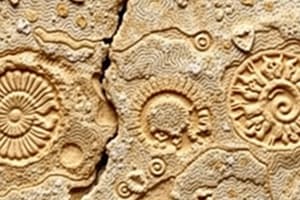Podcast
Questions and Answers
What is the primary purpose of measuring ratios such as length to volume?
What is the primary purpose of measuring ratios such as length to volume?
- To categorize organisms by color
- To record the fossilization process
- To establish rank or ratios between different measures (correct)
- To determine the age of fossils
When making measurements of larger specimens, which tool is recommended for accuracy?
When making measurements of larger specimens, which tool is recommended for accuracy?
- Calipers (correct)
- A compass
- A protractor
- A ruler
Accretion in terms of skeletal growth refers to what process?
Accretion in terms of skeletal growth refers to what process?
- Transformation of soft tissue into bone
- Removal of old skeletal material
- Direct addition of skeletal material onto existing parts (correct)
- Abrasion of skeletal material over time
What is the correct range of measurements for character X?
What is the correct range of measurements for character X?
What can growth lines in a skeleton indicate?
What can growth lines in a skeleton indicate?
What is a major factor that influences the representative nature of a fossil sample?
What is a major factor that influences the representative nature of a fossil sample?
Which of the following values represents the standard deviation of character Y?
Which of the following values represents the standard deviation of character Y?
Which method is NOT a measure of dispersion in specimen collection?
Which method is NOT a measure of dispersion in specimen collection?
What is one reason why growth in organisms is complex?
What is one reason why growth in organisms is complex?
How is the coefficient of variation for character X expressed?
How is the coefficient of variation for character X expressed?
Why is it difficult to describe organisms using only words?
Why is it difficult to describe organisms using only words?
What is the variance of character Y?
What is the variance of character Y?
Why is measuring along the principal axis of growth important?
Why is measuring along the principal axis of growth important?
What challenge arises from the mixing of remains in a fossil bed?
What challenge arises from the mixing of remains in a fossil bed?
What is a potential benefit of using numerical descriptions in paleontology?
What is a potential benefit of using numerical descriptions in paleontology?
What is the 95% confidence interval for the mean of character X?
What is the 95% confidence interval for the mean of character X?
What is one of the purposes of the exercise related to fossils?
What is one of the purposes of the exercise related to fossils?
Which of the following is NOT a type of variable used to describe fossils?
Which of the following is NOT a type of variable used to describe fossils?
Which of these statements accurately reflects the nature of numerical descriptions in paleontology?
Which of these statements accurately reflects the nature of numerical descriptions in paleontology?
What might be a reason for the differing growth patterns in invertebrate animals?
What might be a reason for the differing growth patterns in invertebrate animals?
Which of the following best describes 'ranking along some scale' in the context of variables?
Which of the following best describes 'ranking along some scale' in the context of variables?
What is the ratio of height to width for the genus Tridacna?
What is the ratio of height to width for the genus Tridacna?
What is the inferred life habit of the Tridacna shell?
What is the inferred life habit of the Tridacna shell?
Which of the following describes the shell texture of the genus Tridacna?
Which of the following describes the shell texture of the genus Tridacna?
What type of shell structure do Specimens A and B exhibit?
What type of shell structure do Specimens A and B exhibit?
Which statement accurately describes Specimen C?
Which statement accurately describes Specimen C?
What is the effect of a wider range of values on random sampling?
What is the effect of a wider range of values on random sampling?
Which factor influences the stability of the sample's mean value the most?
Which factor influences the stability of the sample's mean value the most?
What is a common morphological adaptation for pelecypods that use byssal attachment?
What is a common morphological adaptation for pelecypods that use byssal attachment?
How do infaunal pelecypods differ from epifaunal pelecypods in their muscle structure?
How do infaunal pelecypods differ from epifaunal pelecypods in their muscle structure?
Which of the following is NOT a characteristic of byssal attachment in pelecypods?
Which of the following is NOT a characteristic of byssal attachment in pelecypods?
Why is it important to consider the variability of a measured feature in a sample?
Why is it important to consider the variability of a measured feature in a sample?
Which statement about the adaptations of pelecypods is true?
Which statement about the adaptations of pelecypods is true?
What is the overall impact of increasing the sample size in statistical analysis?
What is the overall impact of increasing the sample size in statistical analysis?
Flashcards are hidden until you start studying
Study Notes
Introduction to Growth and Fossil Morphology
- Growth encompasses not just size increase, but changes in bodily proportions and organ addition.
- Relationships among an organism's parts evolve as it grows due to structural necessity or functional adaptation.
- Accurate comparisons of organisms require numerical descriptions rather than subjective verbal or visual representation.
- A combination of qualitative data, illustrations, and numerical techniques enhances objective scientific communication.
Numerical Description of Fossils
- Organism comparison involves scoring observable properties (variables) that differ among individuals.
- Types of variables include:
- Discrete counts (e.g., number of teeth)
- Continuous measurements (e.g., length, volume)
- Ranking by size
- Attributes presence (e.g., bumps)
- Ratios (e.g., length to volume)
- Focus is on measurement description which can establish ranks or ratios.
Measurement Techniques
- Linear measurements should be made along growth axes or maximum and minimum length.
- For larger specimens, use calipers or measure on millimeter graph paper.
- Accretion techniques add skeletal material, leading to growth lines that indicate developmental history.
Measures of Central Tendency and Dispersion
- Fossil remains often comprise multiple populations, thus sample representativeness is critical.
- Size classes may be selectively removed during fossilization, impacting measurements.
- Establish collection techniques such as bulk or grid sampling to ensure comprehensive data:
- Screen sediment thoroughly in the lab.
- Collect from marked grid areas based on random sampling methods.
- Key considerations for measures:
- Range width indicates variability likelihood.
- Higher sample sizes stabilize mean values against outliers.
Functional Morphology of Pelecypods
- Pelecypods have adapted various life habits for diverse environments.
- Distinct morphological adaptations correspond to specific habitats, such as byssal attachment:
- Features include a perpendicular commissure, elongation, and reduced anterior muscle size.
- Variance in anterior tapering and adductor muscle conditions across habitats.
Statistical Analysis for Fossil Measurements
- Calculate arithmetic mean, variance, standard deviation, and coefficient of variation for fossil measurements.
- Example data results:
- Range for X: 0.7 to 1.5; for Y: 1.2 to 1.8
- Variance for X: 0.031 cm²; for Y: 0.026 cm²
- Standard deviation for X: 0.18 cm; for Y: 0.16 cm
- Coefficient of variation for X: 17.3%; for Y: 10.06%
- Generate 95% confidence intervals for mean measurements:
- For X: 0.94 to 1.13; for Y: 1.51 to 1.67
Species Morphology and Life Habits
- Example bivalve genus Tridacna has a height-to-width ratio of 0.372 and length-to-height ratio of 1.8125.
- Shell characteristics:
- Thin-shelled with rigid and wavy exterior.
- Anisomyarian muscle scars indicate functional adaptations.
- Specimen evaluations reveal similarities and differences in shell structure and inferred life habits, such as byssal attachment or intermittent swimming.
Studying That Suits You
Use AI to generate personalized quizzes and flashcards to suit your learning preferences.




